Account-based marketing vs Lead Generation: Finally Explained
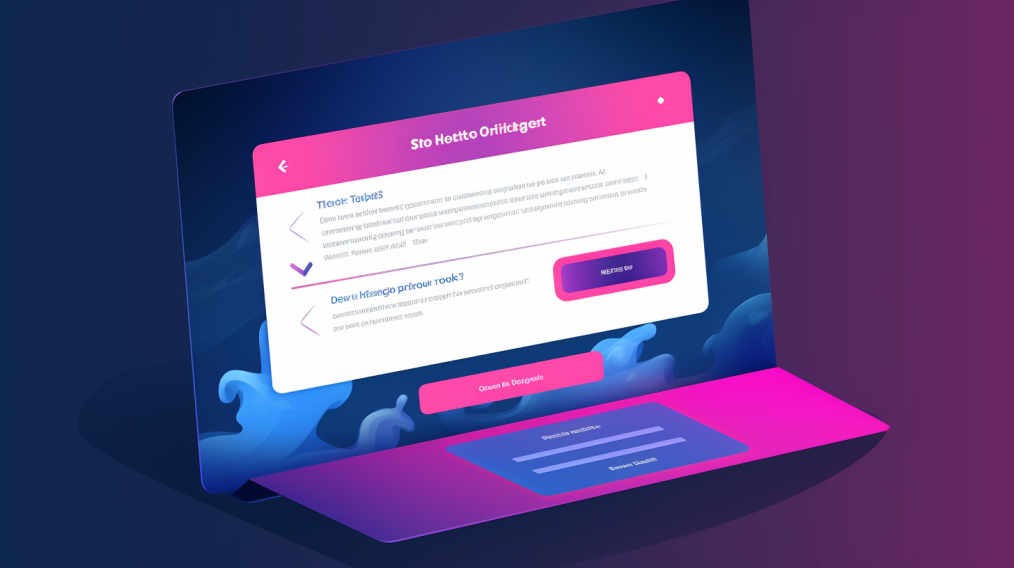
For B2B marketers, the big question about sales funnels is: do you prefer your funnel right-side up or upside down?
In the traditional lead generation model, you seek to bring in lots of leads through the top of the funnel, nurturing them down to the narrow end where you’re left with a few well-qualified leads ready to convert. With account-based marketing, you start with one carefully-selected lead at the top, identify the key decision-makers you need to win over, and build a customized marketing campaign around them.
There are fundamental differences between these two approaches, and it’s not always easy to tell which one is right for your business. The thing is, it doesn’t have to be an either/or decision. Both methods can be complementary when you understand which scenarios they’re best suited for, how to implement them, and what makes them effective.
This post will finally explain the differences between account-based marketing and lead generation so you can put together the ultimate B2B marketing strategy.
What is B2B Lead Generation?
Lead generation (Lead Gen) is the process of identifying prospective customers and getting them interested in your products or services. Then you obtain their contact information and follow up with them in the hopes of nurturing their interest and turning them into a paying customer. In a B2B context, “lead” usually refers to an individual within an organization rather than the organization as a whole.
Lead generation can be outbound, which means reaching out to potential leads with advertisements and cold calls; or inbound, which involves creating content that lures viewers in and encourages leads to seek you out. Leads can be qualified by either your marketing or sales teams, which means those teams have verified that the lead truly has the potential to become a customer.
Lead Gen is the number one priority for most marketers. But generating high-quality, qualified leads remains a perennial challenge, with less than a third of salespeople reporting that their marketing team is their best source for leads.
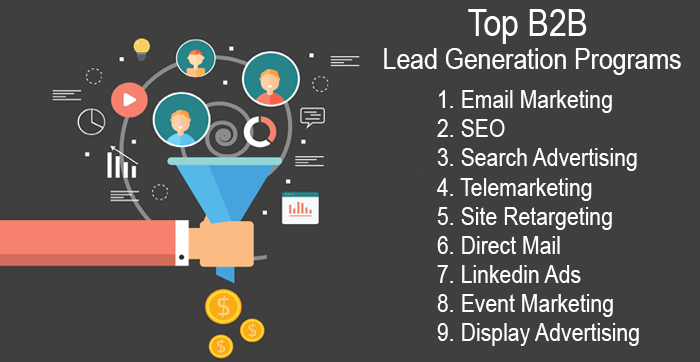
Benefits of B2B Lead Generation
A lead is just a customer that hasn’t purchased yet, so one way to look at them is that they are the raw material your sales team turns into revenue. Without leads, your sales team doesn’t have anyone to purchase your products or services. An active lead generation effort gives your sales team many prospects to work with. It enables you to track conversion rates and make projections about profits and growth.
Lead Gen is critical enough that it is one of the primary (or sole) metrics marketers use to measure the success of a campaign. In a traditional sales funnel, you gather as many leads as you can into the top and use your content and outreach to guide leads further down as they learn more about how your solutions can meet their needs. Unqualified leads will drop off at various points in the funnel, but the more you can get in at the top, the more—in theory—will come out the bottom as qualified and ready to purchase.
What is Account-based marketing?
The B2B account-based marketing (ABM) approach involves choosing target accounts—organizations you think would be likely customers for your product or service—and treating each account as a market in itself. To be successful, ABM requires you to identify individuals with purchase-making influence within the targeted organization and provide them with relevant, personalized content at every stage in their buyer journey.
ABM works best when your sales and marketing teams are working in close alignment, because they’re meant to work the account simultaneously, rather than marketing handing leads off to sales once they’re qualified.
According to experienced marketers, personalized content and data management are the two most important components of a successful ABM campaign. ABM initiatives have expanded considerably in the B2B space in recent years as businesses have become aware of its advantages.
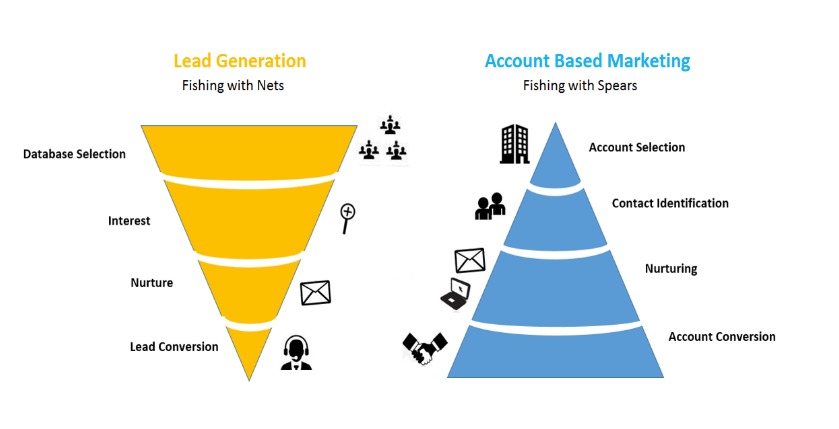
Benefits of Account-based Marketing
A well-executed account-based marketing strategy puts the customer’s needs first and stays closely attuned to where they are at in their process of making a purchasing decision. It presents them with personalized content that speaks directly to the questions, concerns, and hopes they have at that moment. Given that amount of personalized contact, it shouldn’t be surprising that ABM has an excellent track record for concrete measurables like ROI.
According to 87% of marketers who use it, ABM outperforms all their other marketing investments. Companies with mature ABM strategies credit as much as 73% of their total revenue to ABM. One study found that account-based marketing generates greater ROI than other marketing activities in 97% of cases. Implementing a strong ABM program can take a lot more work than traditional marketing alone, and it requires a high degree of buy-in and coordination across all levels of your organization—but the results are hard to argue with.
Lead Generation vs. Account-based marketing
Lead generation and account-based marketing share the same ultimate goals: conversions, sales, and increased revenue. The paths they take to get you there, however, are quite different:
- Lead Gen focuses on establishing contacts with a broad pool of individuals who might be interested in your solutions on behalf of their organization. ABM focuses on identifying target accounts first, then finding out which individuals within that organization need to be contacted.
- Lead Gen requires content with a relatively generic appeal to get many leads into the top of the funnel. ABM requires personalized content that feels highly relevant and engaging to its audience.
- Lead Gen is marketing’s domain, and once marketing nurtures a lead far enough down the funnel to confirm their purchasing intent, they hand them off to sales as a qualified lead. ABM needs sales and marketing to be closely aligned, working together from the very start to generate content and connect with decision-makers at the right moments.
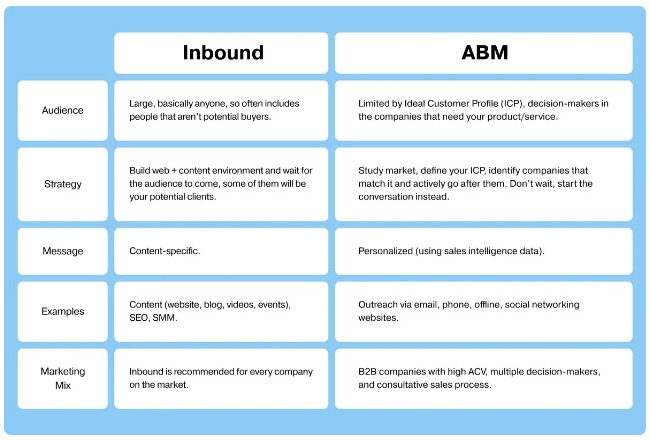
- Lead Gen is designed to cast a wide net, and is easy to scale. With its strong emphasis on personalization, ABM is more costly to scale and is best suited for B2B companies that can focus on a manageable number of high-value accounts.
- Lead Gen gets the best results when utilizing organic channels with a wide reach, such as social media and guest blogging. ABM is much more direct and is better suited to channels such as email, messaging, and live events.
Despite all the ways in which they diverge, lead generation and account-based marketing can work well together—if you know how to implement them correctly.
Best of Both Worlds: The ABM/Lead Gen Hybrid Model
One of the most effective strategies B2B companies have to convert a high-quality prospect is account-based marketing, but lucrative target accounts don’t always materialize on demand. Even for companies that sell highly specialized, industry-specific products, prospective buyers can slip below the radar despite your best efforts to stay informed. A lead generation campaign that runs alongside your ABM efforts can ensure that you’re always nurturing a new crop of leads whose organizations might be good candidates for a full-court ABM press.
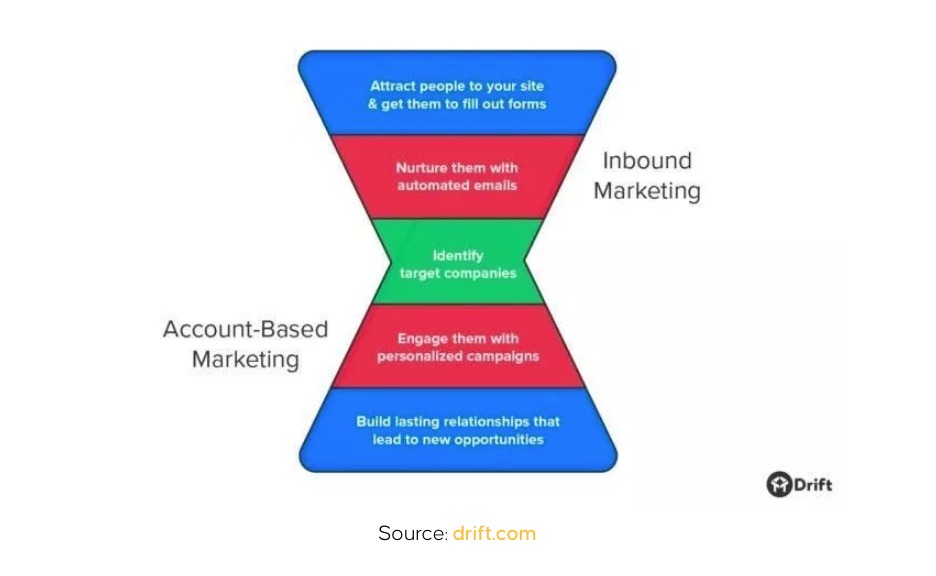
The content you generate through ABM can be repurposed for a general audience to serve as part of an inbound marketing campaign—and vice versa. When you have existing content that generates a lot of clicks and conversions, you can adapt and personalize it to use in your ABM campaign when the time is right. It can be helpful to create a content calendar that ensures you’re frequently engaging your target accounts with new content while keeping your inbound content fresh and up-to-date.
There are many other benefits to implementing a hybrid ABM/Lead Gen model. When your sales and marketing teams work separately, there’s an unfortunate tendency to hoard information in silos. The close alignment between these two teams necessary for successful ABM activities inevitably encourages the sharing of data and insights that can help optimize the performance of both teams. ABM can also help you build closer connections and trust with the decision-makers you engage with, creating opportunities down the line as those individuals move around within the industry.
ABM and Lead Gen: Two Roads, One Buyer Journey
Lead generation and account-based marketing are two different ways for B2B companies to pursue higher sales and revenue, but they aren’t opposed in the final analysis. Together, they form a powerful team that leads to a full and productive sales funnel. Working with both marketing angles simultaneously can be challenging, but it helps when you have tools that automate your marketing activities and provide insights into when and where to deploy your content for the greatest effect.
Solutions like Trendemon can give you visibility into where your leads are in their buyer journey and what kind of engagement they need to feel confident taking the next step closer to a final purchase. For B2B marketers, the two roads of lead generation and account-based marketing are part of one buyer’s journey—and traveling both leads to increased conversions and ROI.